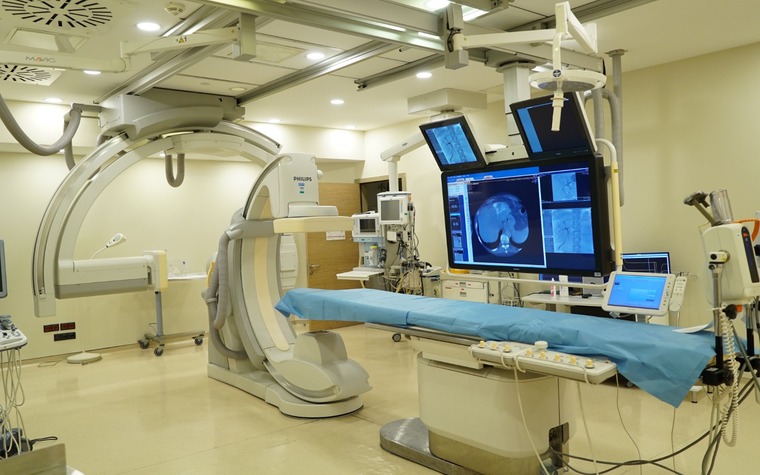
What is Digital Angiography (DSA) and In Which Diseases is It Used?
Digital Subtraction Angiography (DSA) is a medical imaging technique used for detailed imaging of blood vessels. This method is of great importance in the diagnosis and treatment of vascular diseases. DSA clearly shows the internal structure of the vessels using computer technology to obtain high-resolution images. It is widely used especially in the diagnosis of brain, heart and peripheral vascular diseases.
What is Digital Angiography (DSA)?
Digital Subtraction Angiography (DSA) is an advanced radiological technique used to examine blood vessels. It provides clearer and more detailed images than traditional angiography methods. DSA is often used to identify blockages, narrowings, or aneurysms in blood vessels. The images obtained with this method help doctors make an accurate diagnosis and determine the appropriate treatment plan.
How is Digital Angiography (DSA) Performed?
During DSA, a contrast medium is injected into the veins through a catheter. The catheter is usually inserted into the vein in the groin area and directed to the target area. The contrast medium highlights the veins and detailed images are taken with an X-ray machine. These images are processed and clarified with the help of a computer. The procedure is usually performed under local anesthesia and the patient's comfort is ensured.
What is Digital Angiography (DSA) Used For?
DSA is used to detect and treat abnormalities in blood vessels. This method is effective in diagnosing various vascular diseases such as vascular occlusions, stenosis, aneurysms and arteriovenous malformations. It is also used to evaluate the success of some treatment methods. With DSA, many vascular diseases can be diagnosed and treatment plans can be created without the need for surgical intervention.
In Which Diseases Is Digital Angiography (DSA) Used?
Digital Angiography (DSA) is usually applied to patients who have been diagnosed with vascular disease through imaging methods such as tomography or MRI and who cannot be cured with drug therapy. The main diseases and conditions for which this method is used are:
- Vascular Stenosis: Narrowing of the arteries can block blood flow and lead to serious health problems. DSA is used to detect these stenoses and create a treatment plan.
- Aneurysms: In cases where there is a balloon-like expansion in the vessels (aneurysm), the size and location of the aneurysm is determined by obtaining detailed images with DSA.
- Arteriovenous Malformations: In cases such as vascular tangles and abnormal vascular formations, DSA allows detailed examination of these structures.
- Prostatic Enlargement: In patients with prostate enlargement, vascular structures can be examined with DSA.
- Hemorrhoids: DSA can be used to treat hemorrhoids for detailed examination of the veins.
- Varicocele: In cases of enlarged veins in the testicles (varicocele), DSA provides detailed information about the condition of the veins.
- Miyom: Rahimde miyom bulunan hastalarda, DSA ile damar yapıları değerlendirilebilir.
Since contrast material is used in patients undergoing DSA, kidney function must be normal. In addition, caution should be exercised when performing DSA in cases such as hyperthyroidism. In this way, the most appropriate diagnostic and treatment method can be determined by considering the health status of the patients.
Who Can Get Digital Angiography (DSA)?
Digital Angiography (DSA) is used to treat patients who are at risk of developing vascular disease or who require detailed vascular images for the diagnosis and treatment of these diseases. The main patient groups for which DSA can be applied are:
- Patients with Suspected Vascular Disease: DSA is used to make a definitive diagnosis in patients with suspected vascular diseases such as vascular occlusions, stenoses, or aneurysms.
- Patients Diagnosed with Vascular Disease: DSA is performed for more detailed examination in patients who have been diagnosed with vascular disease through imaging methods such as tomography or MRI and who have not been able to improve with drug therapy.
- Cardiovascular Diseases: DSA is used to detect vascular occlusions and narrowing in patients who have had a heart attack or stroke.
- Peripheral Artery Diseases: In patients with vascular occlusions in the legs or arms, DSA allows detailed examination of the vascular structures in these areas.
- Prostatic Enlargement, Hemorrhoids, Varicocele, and Fibroids: In these cases, DSA can be used to evaluate the condition of the veins and create a treatment plan.
- Aneurysms and Arteriovenous Malformations: DSA can be performed to diagnose and monitor conditions such as aneurysms or arteriovenous malformations.
Since the DSA procedure is performed using contrast material, it is applied to patients with normal kidney function. In addition, caution is required in some cases, such as hyperthyroidism. DSA can be applied to patients of almost any age group when deemed necessary by the doctor and helps determine the most appropriate diagnosis and treatment method, considering the patient's general health condition.
How Long Does Digital Angiography (DSA) Take?
Digital angiography varies depending on the disease and the type of procedure performed. If it is for diagnostic purposes, brain angiography takes between 10 and 20 minutes. Among the procedures performed for therapeutic purposes, brain aneurysms vary between approximately one and three hours. However, liver tumor embolizations are completed within an average of 30 minutes. Digital angiography duration may be longer or shorter depending on the procedure and the disease.
Is Pre-Preparation Necessary Before Digital Angiography?
In digital angiography, the preliminary preparation varies according to the procedure performed. Especially in cases of cerebrovascular diseases, when the intervention is for therapeutic purposes rather than diagnostic purposes, the patient must fast for 12 hours. If it is for therapeutic purposes, the procedure is performed under general anesthesia, ensuring that the patient remains completely still. In cases of cerebrovascular diseases performed for diagnostic purposes, digital angiography is performed without anesthesia.









